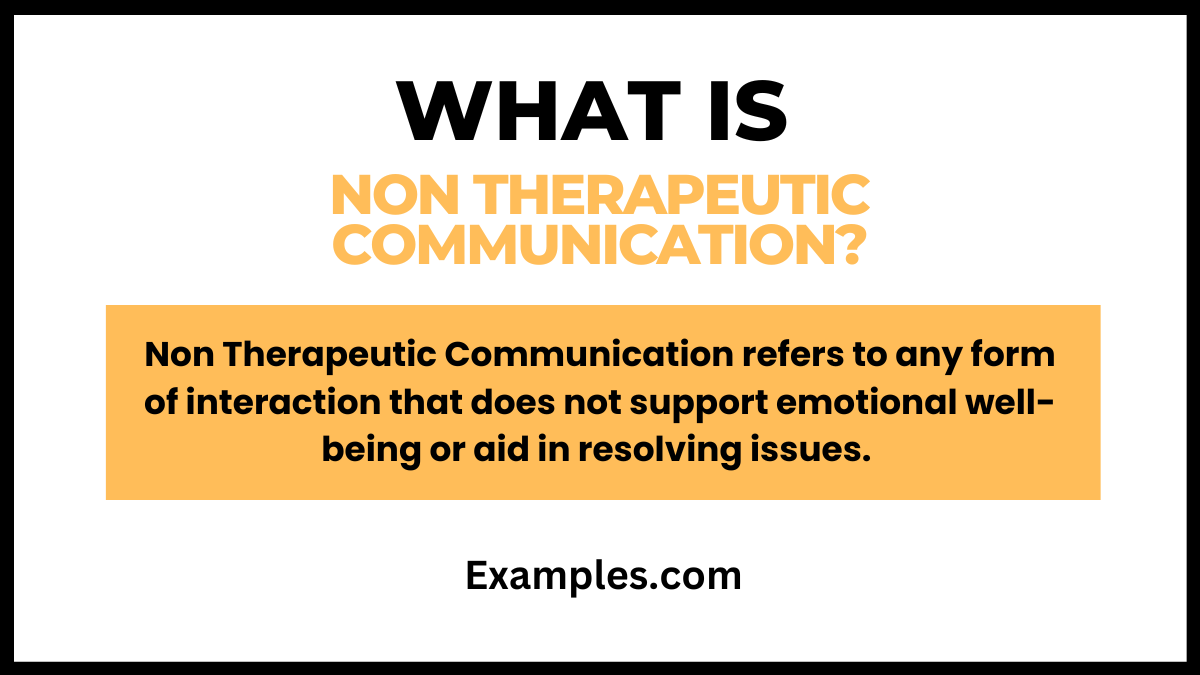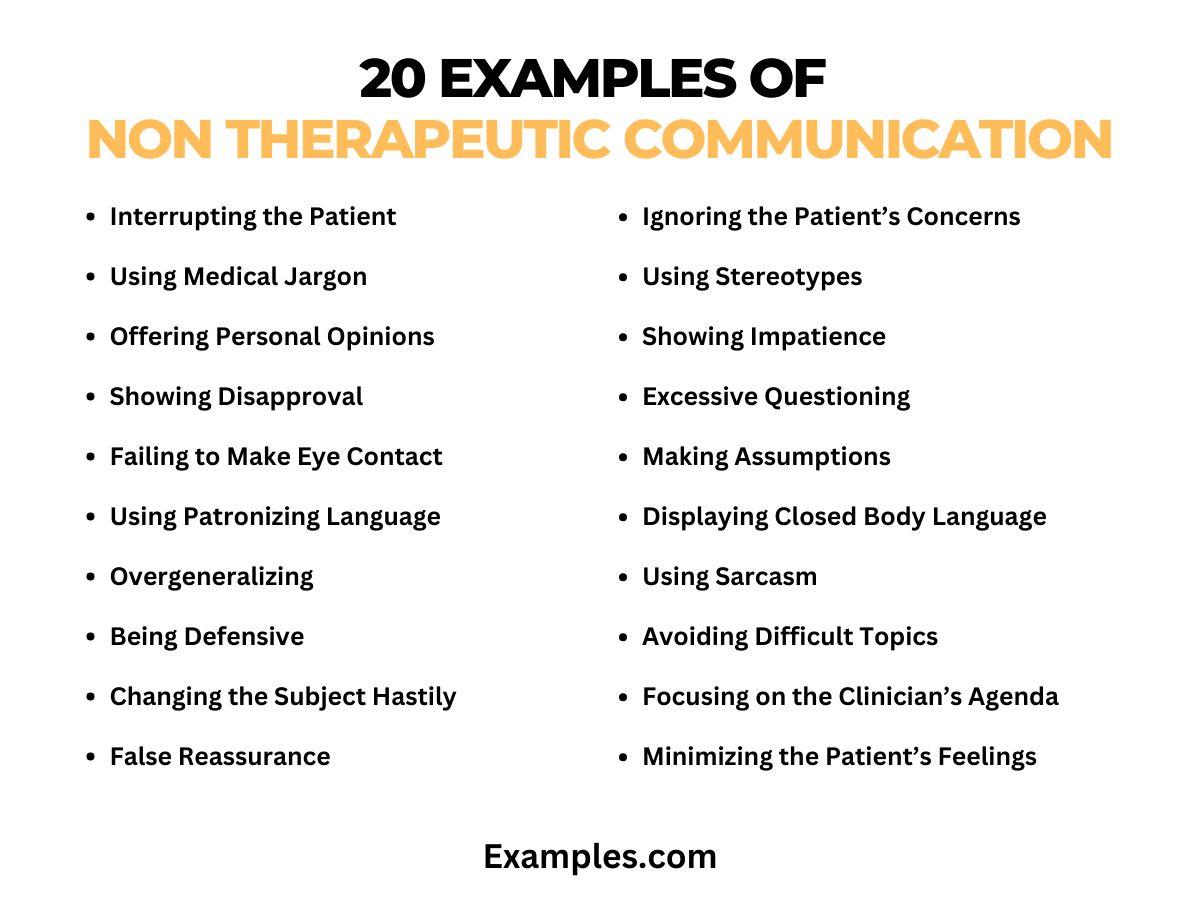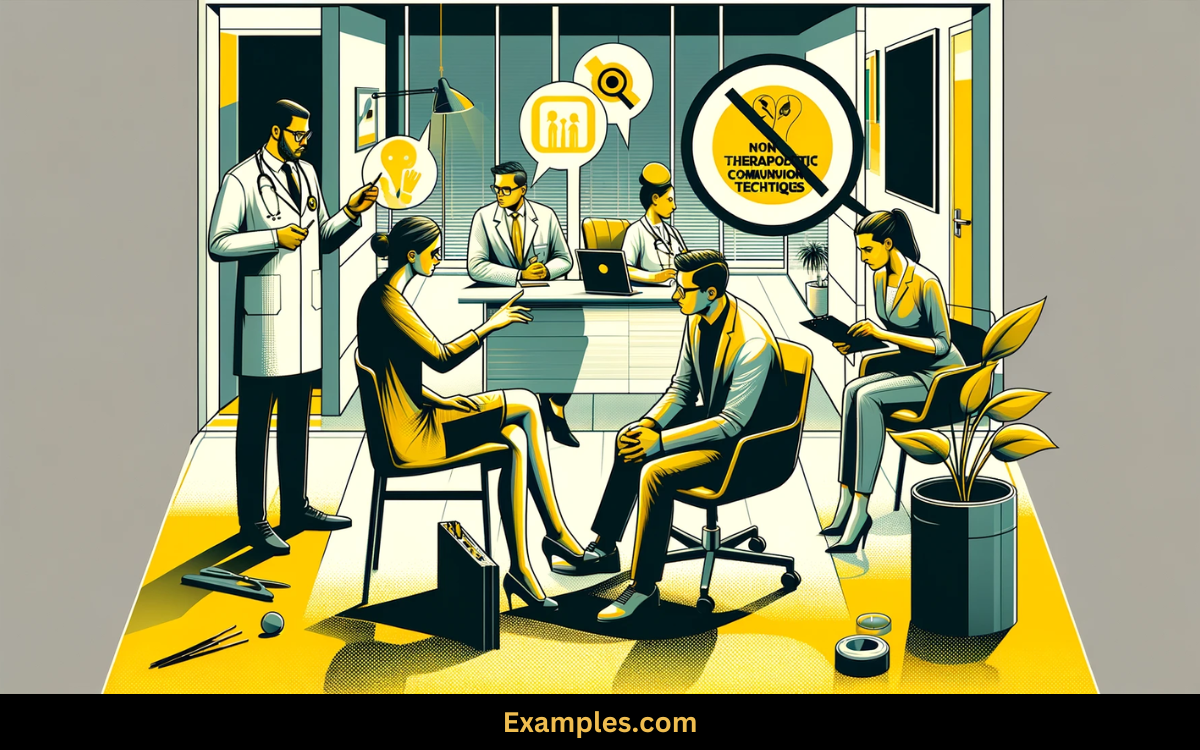19+ Non Therapeutic Communication Examples
Dive into the intricate world of Non Therapeutic Communication with our comprehensive guide, enriched with practical oral Communication Examples. This resource meticulously explores various forms of communication that might hinder therapeutic progress, particularly in healthcare settings. Each section is packed with sentence examples, illustrating how certain communication styles can negatively impact patient care. Ideal for healthcare professionals and students, this guide aims to enlighten readers on identifying and transforming non therapeutic communication patterns into more effective, empathetic interactions, fostering better patient relationships and outcomes.
What is Non Therapeutic Communication?

Non Therapeutic Communication refers to any form of interaction that does not support emotional well-being or aid in resolving issues. It includes communication styles that can be dismissive, judgmental, or ignore the other person’s perspective. In healthcare, this type of communication can hinder the healing process, as it fails to provide the support, empathy, or understanding necessary for effective therapy or patient care. It contrasts with therapeutic communication, which aims to foster understanding, build trust, and promote healing.
20 Examples of Non Therapeutic Communication
Explore the critical aspects of Non Therapeutic Communication with our detailed guide, showcasing 20 unique examples. Each instance is carefully selected to illustrate the various forms of communication that can negatively impact therapeutic relationships, particularly in healthcare settings. These examples, rich in SEO and NLP-friendly content, provide clear demonstrations of ineffective communication styles, offering valuable insights for healthcare professionals. Understand the importance of avoiding these communication pitfalls to maintain a supportive, empathetic environment conducive to healing and positive patient interactions.
- Interrupting the Patient: Cutting off a patient mid-sentence, showing a lack of respect for their thoughts.
- Using Medical Jargon: Overloading a conversation with complex medical terms, making it hard for patients to understand.
- Offering Personal Opinions: Imposing personal beliefs or opinions on patients, which can skew objective judgment.
- Showing Disapproval: Expressing judgment or disapproval in response to a patient’s feelings or experiences.
- Failing to Make Eye Contact: Lack of eye contact during conversations, indicating disinterest or detachment.
- Using Patronizing Language: Speaking in a condescending tone, which can belittle or offend the patient.
- Overgeneralizing: Making broad, generalized statements that don’t acknowledge the patient’s unique situation.
- Being Defensive: Reacting defensively to patient feedback or complaints, hindering open communication.
- Changing the Subject Hastily: Abruptly changing the topic, signaling discomfort or unwillingness to engage in certain discussions.
- False Reassurance: Offering unfounded reassurances, which can undermine trust and invalidate patient concerns.
- Ignoring the Patient’s Concerns: Overlooking or dismissing what the patient expresses, leading to a lack of understanding.
- Using Stereotypes: Making stereotypical assumptions about a patient’s condition or behavior.
- Showing Impatience: Exhibiting signs of impatience, which can make the patient feel rushed or unimportant.
- Excessive Questioning: Bombarding the patient with questions, leading to feelings of being interrogated rather than heard.
- Making Assumptions: Jumping to conclusions without fully understanding the patient’s perspective.
Non Therapeutic Communication Techniques
Non Therapeutic Communication Techniques encompass various communication behaviors that are counterproductive in a therapeutic setting. These techniques can hinder understanding, rapport, and trust between healthcare professionals and patients. This section delves into specific non therapeutic communication methods, providing real-world examples and explanations of why they are ineffective or potentially harmful. From dismissive gestures to insensitive remarks, understanding these techniques is crucial for professionals aiming to foster a supportive and healing environment for their patients.
- Rapid-Fire Questioning: Bombarding patients with too many questions, making them feel overwhelmed.
- Ignoring Non-Verbal Cues: Overlooking a patient’s body language or emotional signals, missing vital communication aspects.
- Using Clichés: Relying on overused phrases that can seem insincere or trivialize a patient’s experience.
- Providing Unwanted Advice: Offering unsolicited advice, which can undermine the patient’s autonomy and decision-making.
- Judgmental Comments: Making comments that come across as judgmental or critical, eroding trust.
- Over-Simplification: Oversimplifying a patient’s problems, which can belittle their experience and invalidate their feelings.
- Disregarding Patient’s Input: Ignoring or not valuing the patient’s thoughts and opinions during discussions.
- Excessive Self-Disclosure: Sharing too much personal information, shifting focus away from the patient’s needs.
- Projecting Personal Biases: Allowing personal prejudices to influence interactions with patients.
- Closing Off Conversations: Shutting down conversations prematurely, not allowing patients to fully express themselves.
Difference Between Therapeutic and Non Therapeutic Communication
| Therapeutic Communication | Non Therapeutic Communication |
|---|---|
| Facilitates healing and understanding | Often leads to misunderstanding and emotional distance |
| Patient-centered, empathetic | May be dismissive, judgmental |
| Active listening, validating feelings | Often involves poor listening, ignoring patient cues |
| Non-judgmental, supportive | Can be critical, dismissive |
| Focuses on the patient’s needs and emotions | Often focused on the communicator’s perspective |
| Encourages open and honest dialogue | May shut down or limit conversation |
| Tailored to individual patient needs | One-size-fits-all approach, inflexible |
| Seeks to understand and clarify | Often disregards patient’s feedback |
| High empathy, with emotional understanding | Low or absent, lack of emotional connection |
| Builds trust and rapport | Can erode trust and hinder therapeutic progress |
What May Be Non-Therapeutic Ways of Blocking Communication?
Non-therapeutic communication encompasses behaviors or techniques that hinder or block effective communication, especially in healthcare and psychological settings. Understanding these barriers is crucial for professionals to foster more effective Therapeutic Communication in Healthcare and avoid pitfalls in patient interactions. This guide delves into various non-therapeutic ways that can obstruct communication, emphasizing their impact and how they contrast with Therapeutic Communication Techniques.
Using Medical Jargon
Overuse of medical or technical language can be confusing and intimidating for patients, creating a barrier to understanding. This contrasts with Clarification in Therapeutic Communication, where complex terms are broken down into simpler language.
Offering Unsolicited Advice
Providing advice without fully understanding the patient’s situation or without their request can be perceived as dismissive. In Therapeutic Communication in Nursing, it’s vital to explore the patient’s feelings and viewpoints before offering solutions.
Interrupting the Patient
Interrupting patients while they are speaking can make them feel unheard and undervalued, a stark contrast to Active listening in Therapeutic Communication, where the patient’s narrative is given priority.
Showing Judgment or Bias
Displaying judgment or bias, whether verbal or nonverbal, can make patients feel insecure and less likely to share openly. This is counterproductive to Accepting in Therapeutic Communication, which promotes a nonjudgmental and supportive environment.
Minimizing Patient’s Feelings
Downplaying or dismissing patient’s feelings can lead to a lack of trust and openness. In Therapeutic Communication for Depression, for instance, acknowledging and validating feelings is crucial for effective communication.
What is Therapeutic and Non-Therapeutic Communication?
Understanding the distinction between therapeutic and non-therapeutic communication is essential for professionals in healthcare and psychology. This guide provides a comprehensive overview of both, highlighting their characteristics, applications, and the impact they have on patient care and therapeutic outcomes.
Therapeutic Communication
Therapeutic communication is an empathetic and patient-centered approach that fosters a positive patient-clinician relationship. It involves techniques like Active listening, Reflecting, and Summarizing, all aiming to understand and validate the patient’s experiences and feelings. This type of communication is essential in settings like Therapeutic Communication in Psychiatric Nursing and Therapeutic Communication with Elderly Patients, where understanding patient perspectives is key to effective care.
Non-Therapeutic Communication
Non-therapeutic communication, on the other hand, includes behaviors and techniques that can create barriers or negatively impact the patient-clinician relationship. These include being judgmental, interrupting, using complex jargon, and providing false reassurance. Such communication styles are counterproductive in scenarios like Therapeutic Communication for Anxiety or Therapeutic Communication in Pediatric Nursing, where building trust and understanding is critical.
Key Differences
The primary difference lies in the impact on the patient. Therapeutic communication aims to empower, support, and understand the patient, enhancing their comfort and trust. Non-therapeutic communication can lead to misunderstandings, reduced trust, and a feeling of being undervalued or misunderstood. Recognizing these differences is crucial in fields like Therapeutic Communication in Mental Health Nursing and Ethical Therapeutic Communication.
In conclusion, understanding and differentiating between therapeutic and non-therapeutic communication forms the backbone of effective patient care. Professionals equipped with this knowledge can navigate patient interactions more effectively, ensuring better health outcomes and enriched patient experiences.



